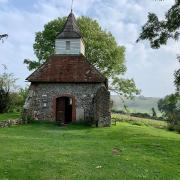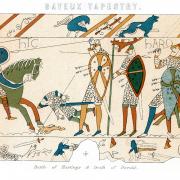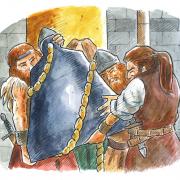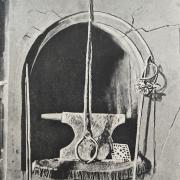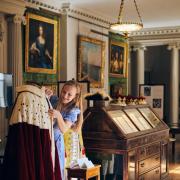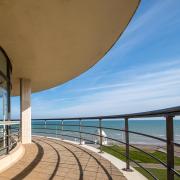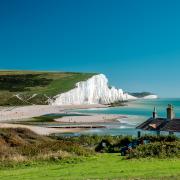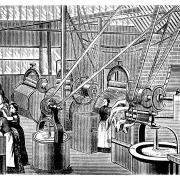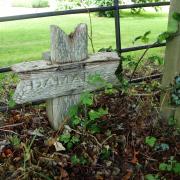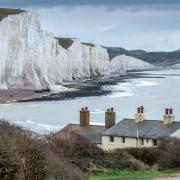A pioneering technique in the 19th Century captured iconic Sussex seaside scenes and market towns vistas in vivid hues giving us a fascinating look into history
Seaside postcards have had what many historians would call a colourful past. But risqué jokes and cartoon saucy images aside - which became so popular they sold a staggering 16 million a year - those from the Victorian and Edwardian periods were black and white, making such early scenes seem stiff or remote.
That all changed when a remarkably innovative technique was invented in the 1880s that magically transformed a single black and white negative into glorious and realistic - at least for the time - colour using lithographical printing plates.
Between six to 15 tint stones were used to produce each one, and the photographer would provide extensive notes to ensure the lithographers applied the right colours.
The unique, painterly result, unlike hand-tinted photography, was relatively quick, simple and cheap to produce, making it ideal for commercial use and the images metamorphosed into postcards.
A craze for collecting them started, and once the Royal Mail gave permission in 1894 for them to be made and sent in the post, a booming industry was born. Steam locomotives made travelling to the coast affordable, and seaside scenes aimed at the emerging tourist industry became firm favourites for visitors to send home.
The bulk of Photochrom production, between 1890 and 1910, specialised in these coastal scenes, as well as landscapes, nature, architecture, landmarks and beauty spots for the mass market. Historic and civic landmarks, parks, social scenes and train stations were portrayed too.
Luckily, Photochroms collections have survived to give us a glimpse into history and show how Sussex seafront and market towns looked all those years ago.
Though the photochroms are anonymous and individual photographers cannot be linked to specific images, we know of some individuals whose work will have been included in the Photochrom collections.
The best known will be Francis Frith who was arguably the most renowned British photographer for the mass market at the time.
Now his and other photographers' work has been published in a volume of The British Isles in Colour: Photochrom photography 1890-1910 ( Lone Fox Publishing, £16.99) focusing on southern England including Sussex.
They give us a fascinating look into the past at famous Sussex locations and landmarks, no doubt making many of us ask: 'Wish You Were Here?'
East Parade, Bognor Regis
It is likely that this image was taken by Francis Frith as there is another very similar image in his collection, probably taken on the same day, sometime between 1880 and 1890. The original title simply referred to Bognor because the honorific ‘Regis’ wasn't added until 1929 upon the stay of King George V.
The numerous bathing huts, used for changing into swimming suits before being rolled into the sea in order to make a dignified entrance into the waves, are a notable feature. The stationary one on the upper left may have been used in the modern sense of a beach hut.
Alongside Brighton, Bognor was a most fashionable and genteel resort. In popular locations, local fishermen combined their commercial fishing activities with pleasure trips for holiday makers, giving them the opportunity of an additional income, and the boats visible could have been for this purpose.
The Metropole Hotel and the Grand Hotel, Brighton

This image of two of Brighton’s iconic hotels must have been taken after 1890 as that was the year hotel on the left, The Metropole, was built. Its architect was Alfred Waterhouse, an exponent of the Victorian Gothic Revival who also built the Natural History Museum in London, in 1881, among others.
The six-storey Metropole was built using red bricks, which was shocking at the time as it broke away from the customary white stucco)buildings of the English seafront favoured during the Regency period.
Waterhouse’s Metropole included many luxury features including a ballroom and Turkish baths. The characteristic spire and French pavilion roof were removed in 1960. Today the hotel is part of the Hilton chain, but due respect is still paid to its august architect in the form of the Waterhouse Bar & Terrace.
To the Metropole’s right on the picture is the earlier Grand Hotel, designed in Italianate style by John Whichcord, Jr. for the upper classes in 1864. Built over 18th century coastal fortifications, an example of its exclusivity was its remarkable ‘Ascending Omnibus’ or hydraulically powered lift, one of only three in existence in the country at the time, and the first outside London.
This view would be difficult to recreate today as the photograph was taken from the West Pier, which was destroyed beyond repair in 2003 after two fires. Opened in 1866, the pier was built to attract tourists to the town and reached its height of popularity between 1916 and 1919 when a concert hall was added.
But after World War 2 it fell into decline and was closed in 1975. Although it was the first pier to gain Grade 1 listed status, it fell into disrepair and was largely derelict by the 2000s.
South Street, Worthing

The old Town Hall, which opened in 1835, at the junction of South Street, Warwick Street and Chapel Road, is the centre piece of this photograph. Sadly, the building, with its tower and portico, for so long the focus of the town, was demolished in 1966, 30 years after a new Town Hall was built further to the north on Chapel Road.
Francis Frith took photographs of this vista in 1895, 1899 and 1919. The one entitled ‘South Street 1899’ is the closest to our Photochrom version. The one he sold to be made into a Photochrom though seems more exciting as it includes the man to the right on stilts! The Francis Frith Collection informs us that underneath the Town Hall building there were prison cells and a hand-operated fire engine.
High Street, Battle

Taken before the domination of the motorcar, this picture of Battle High Street with its carts and horses is thoroughly nostalgic.
According to Martin Andrew, author of Sussex Photographic Memories (2000), the plot boundaries of the High Street go back to the late 11th century. It remains largely unchanged with the Abbey Hotel still going strong. The Grade II listed hotel, also has a bar and restaurant offering Shepherd Neame beer.
A similar picture to the one above taken from a little further back on the road which reveals another building and announcements such as ‘luncheons and tea’ is dated in the Frith archives as 1910.
Herstmonceux Castle

This image of an overgrown Herstmonceux Castle in the 1890s looks very different to the attraction of today. The castle was stripped out and abandoned in the 1770s, which explains its ruinous state in the image.
Listed as Grade II* on the Register of Historic Parks and Gardens, this local gem harks back to the 15th century. It is regarded as one of the finest early brick buildings in England.
In 1320 Maud de Monceux married the lord of the manor giving the castle the second part of its name; the Anglo-Saxon ‘hyrst’ of the first part means a wooded hill.
When Sir Roger Fiennes, a knight who had fought with Henry V in Agincourt, became appointed Treasurer to the Household of Henry VI, the receipt of a royal grant enabled him to convert his manor house into a luxurious military-style castle in 1441.
Beautiful even as a ruin, it became a popular visitor attraction, prompting the interest of many eminent photographers to immortalise it. This picture is most likely derived from a black and white original by George Washington Wilson with an estimated date of 1896.
Francis Frith, Carl Norman and others also took evocative photographs of this castle. Today its renowned formal gardens and parkland and magnificent moated castle refurbished by Queen’s University Ontario, who own the site, have replaced its romantic desolation.
The beach and fish market, East Cliff, Hastings

This beautiful shingle beach is called The Stade, which in Anglo-Saxon means landing place. Though this image has not been identified it could be a coloured version of a photograph by noted Hastings photographer George Woods who took many fascinating images of fishermen, the beach at Hastings and local life in the 1890s.
The fish market was established in the Victorian period and the fishing fleet is the largest beach-launched fishing fleet in the UK today. The fishermen’s net ‘shops’, the tall, black, wooden, weather-proof buildings behind the fishing boats, were built to store the nets and protect them. The fishing nets were traditionally dried on the beach before storage.
The Stade is still a thriving fishing beach today, praised for its sound environmental practices including the protection of young cod. A fishermen’s museum in the town gives visitors more details of the importance of the fishing community to Hastings.
The British Isles in Colour: Photochrom photography 1890-1910 from Lone Fox Publishing has a volume on Southern England and the Channel Islands. £16.99




